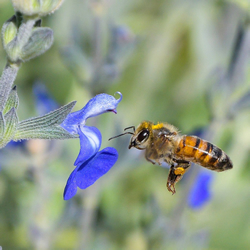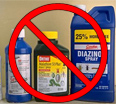How Are Pesticides Affecting Water Quality?
Contamination of creeks, rivers, and oceans

California creeks, rivers, and oceans are being contaminated with pesticides and other chemicals commonly used around our homes and gardens. These garden chemicals are not only a threat to aquatic life, but they can also affect the quality of our drinking water.
Toxicity to living organisms
 Photographer: George Lopez
Photographer: George Lopez
All pesticides are toxic at some level, but each varies in their toxicity to humans and other animals. Organophosphates, including diazinon and chlorpyrifos, are insecticides that contain phosphorus; they are nerve poisons and act by inhibiting important enzymes in the nervous system in animals. Pyrethroids are another class of insecticides that are not as toxic to humans and other mammals, but are quite toxic to fish and invertebrates. Both the organophosphates and pyrethroids pose serious threats to aquatic invertebrates in California waterways.
Known problem pesticides: pyrethroids and organophosphates
Pyrethroids are common residential insecticides, found in products for ant control, home lawn, garden and landscape care, as well as in structural pest control products. Common pyrethroid active ingredients in home use products include bifenthrin, cypermethrin, permethrin, and cyfluthrin. Pyrethroids mimic the mode of action of the plant-derived pesticide pyrethrin, but are much more toxic and persistent in the environment. They attach to soil particles and are washed into waterways on sediment.
Known problem pesticides (cont.)
Organophosphate pesticides containing diazinon and chlorpyrifos were widely used in the 1990s but were withdrawn from the market for home use in the early 2000s because of risks to children. These materials are highly soluble in water and have been found in California creeks at levels toxic to aquatic invertebrates.
You may still have products containing diazinon and chlorpyrifos on a shelf in your garage. If you have these products, dispose of them at your local Household Hazardous Waste site. Call 1-800-CLEANUP (1-800-253-2687) to find a disposal site in your area.

Other organophosphate insecticides are still available for home use include malathion, acephate and disulfoton. These products are also water soluble, broadly toxic and pose risks for aquatic organisms. Avoid their use where possible and keep them out of our waterways.
Select pesticides carefully before you buy or apply
The first step in choosing a pesticides is to accurately identify the pest. If a pesticide is needed, select one that is effective against your pest and also poses the least risks to human health and the environment. Refer to the home and garden pests section of the UC IPM website for environmentally friendly solutions. Pesticide labels provide information on the active (toxic) ingredients contained in a product. Always read the label before applying a pesticide.
All pesticides must be used with caution and should never be allowed to go into stormwater, drains, or creeks. For some pesticides, the full impact on the environment is not known.
